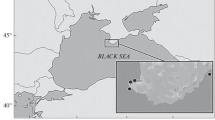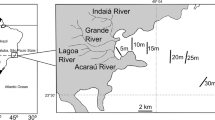Abstract
The regular sea urchin, Strongylocentrotus pallidus (G.O. Sars, 1871), is a widespread epibenthic species in high-Arctic waters. However, little is known about its distribution, standing stock, population dynamics and production. In the northern Barents Sea, S. pallidus was recorded on seabed still photographs at 10 out of 11 stations in water depths of 80–360 m. Mean abundances along photographic transects of 150–300 m length ranged between <0.1 and 14.7 ind. m−2 yielding a grand average of 3.6 ind. m−2. The small-scale distribution along the transects was patchy, with densities varying from nil to an overall maximum of 25.5 ind. m−2, and exhibited a significant relation to the number of stones present. Sea urchin test diameters, measured on scaled photographs, extended from 7 to 90 mm. Median values at single stations varied from 14 to 46 mm, showing a significant inverse relationship to water depth. Biomass, estimated by combining photographic abundances, size frequencies and a size-mass function established with trawled specimens, ranged between <0.1 and 3.0 g ash-free dry mass m−2, averaging about 1.0 g ash free dry mass m−2. An analysis of skeletal growth bands in genital plates was carried out with 143 trawled individuals ranging in test diameter (D) from 4 to 48 mm. Assuming these bands to represent annual growth marks, the ages of the specimens analysed ranged between 3 and 42 years. A von Bertalanffy function was fitted to size-at-age data to model individual growth pattern (D∞ = 102.3 mm, k = 0.011 year−1, t0 = 0.633 year). The annual mortality rate Z of the population in the northern Barents Sea was estimated from a size-converted catch curve to be 0.08 year−1. Applying the weight-specific growth rate method, the average P/B ratio and the mean annual production of this population were estimated as 0.07 year−1 and 0.076 g AFDM m−2 year−1, respectively. In conclusion, S. pallidus is characterized by slow growth, low mortality, high longevity and low productivity. Because of its relatively high biomass, it is considered to contribute significantly to total benthic standing stock and carbon flux in the study area.
Similar content being viewed by others
Author information
Authors and Affiliations
Additional information
Received: 9 October 1997 / Accepted: 5 May 1998
Rights and permissions
About this article
Cite this article
Bluhm, B., Piepenburg, D. & von Juterzenka, K. Distribution, standing stock, growth, mortality and production of Strongylocentrotus pallidus (Echinodermata: Echinoidea) in the northern Barents Sea. Polar Biol 20, 325–334 (1998). https://doi.org/10.1007/s003000050310
Issue Date:
DOI: https://doi.org/10.1007/s003000050310




